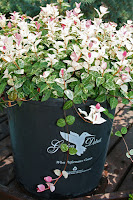 |
| Bahama Pink Sky(TM) Daylily, PPAF |
Daylilies
(Hemerocallis species and cultivars)
are reliable, easy-care perennials useful for adding color to perennial beds,
shrub borders or for erosion control on slopes. Dayliles are ideal perennials, tolerant of most
soils, of wet weather and drought, of sun and shade, handle heat stress well,
are pretty free of pests and make a carefree addition to the landscape.
Their
colorful, trumpet-shaped blooms each last only a single day, but since each
clump produces many buds, the colorful effect is long-lasting. In addition, the
Enjoy 24/7™ Daylily Collection from Garden Debut® has multiple flowering periods
throughout the season, beginning in April and continuing though Thanksgiving(!).
 |
| Candelabra Flower Scape |
Candelabra or Branched Flower Scapes
Since
the total number of flowers and resulting bloom season of a well-established
plant depends on the number of buds, a flower stalk that is loaded with buds has
a long bloom period. The scape is the entire flower stalk arising from the
center of the clump known as the crown; a tall, sturdy flower stalk without
leaves but having a few green bracts as well as multiple flower buds. Some scapes
are branched and display flowers to advantage and these are called branched
scapes or ‘candelabra scapes’.
Pictured at right is a candelabra scape of Bahama Pink Sky™ Daylily blooming once again in
early September with multiple flower stalks or scapes (6) distributed among two
clumps. Each scape carries multiple buds so the perennials are able to bloom
for a long period. In particular, Enjoy 24/7™ Daylilies http://www.gardendebut.com/enjoy-247-daylilies.php
are exceptional bloomers,
beginning in April and continuing through Thanksgiving.
 |
| Multiple Branched Scapes |
To purchase the Enjoy 24/7™ Daylily Collection from Garden Debut, ask your retailer http://www.gardendebut.com/retailers.php to offer them this fall. Remember the horticultural slogan, “Fall is for Planting” and plant some this month.















.jpg)




